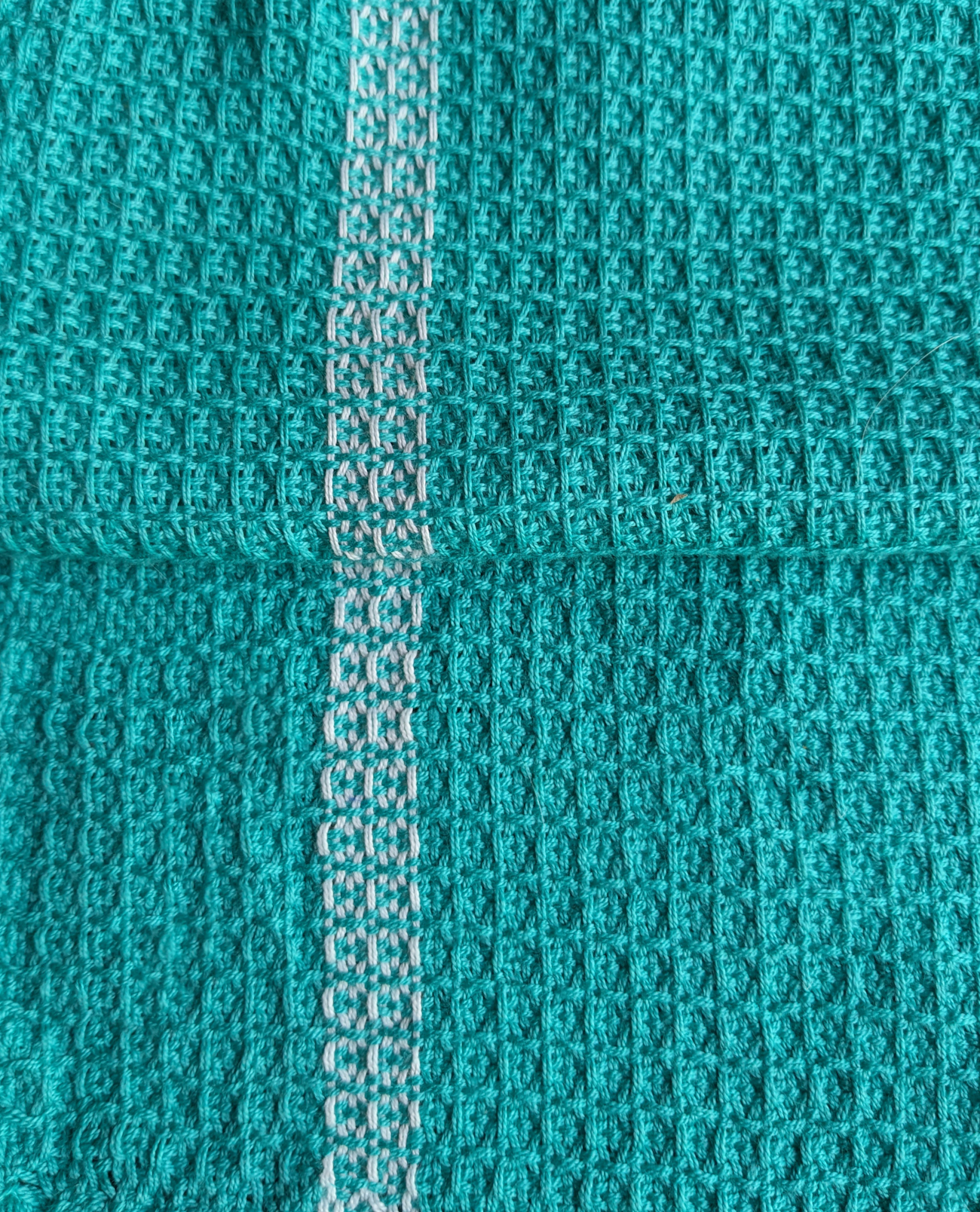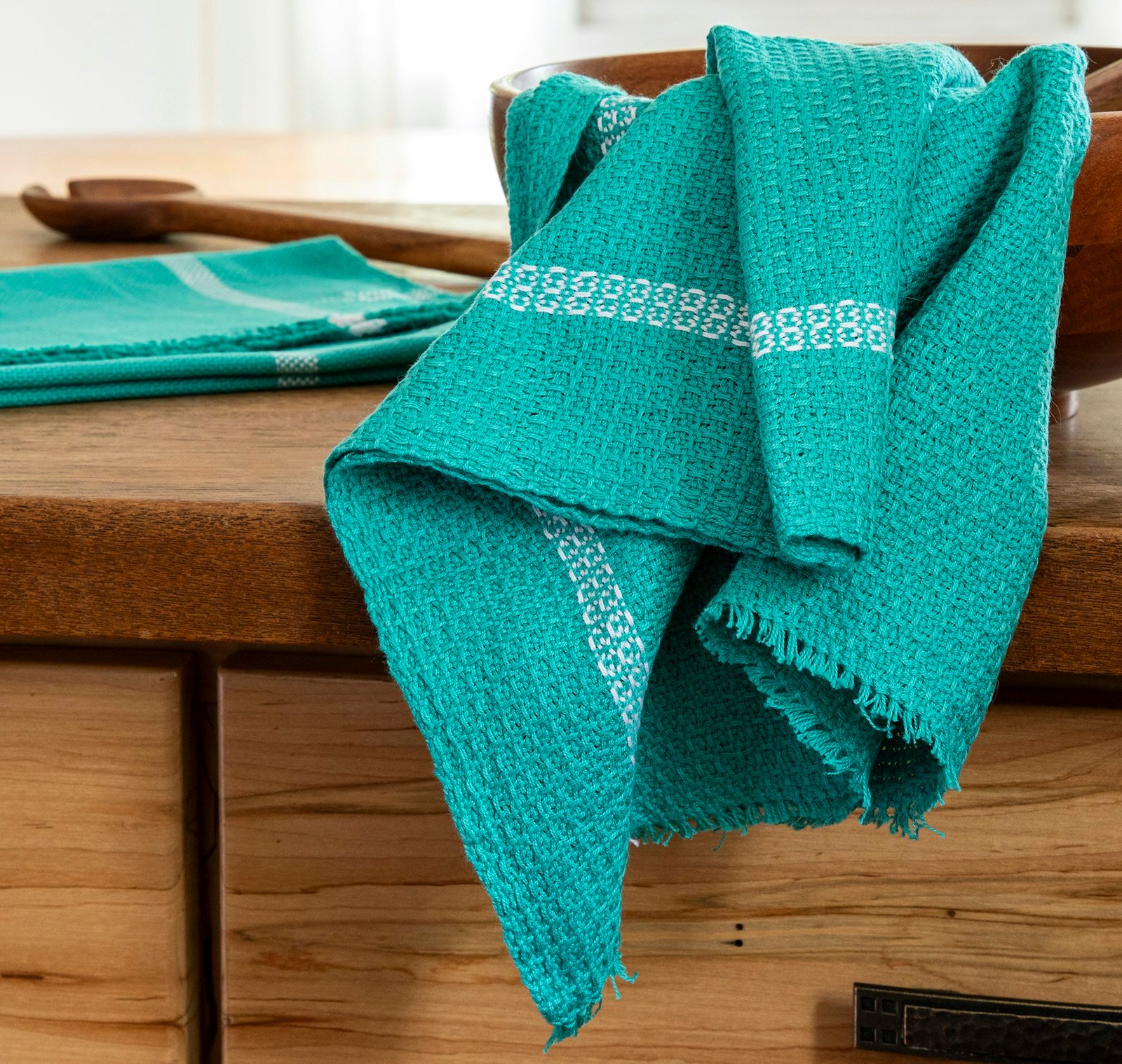The first time I saw a Kerala towel, I nearly cut it up for rags. Then I tried one—and I was hooked. This is the story of the Kollam Towels, the pair of rigid-heddle towels I designed for Little Looms Fall 2025.
Introducing Kerala Towels
Helping my husband sort through old clothes he’d brought from India decades earlier, I found a few thin, plain pieces of unmercerized cotton cloth with no hems or trim. With just a stripe of teal or green in the warp, they didn’t look like much; the texture was neither silky nor plush. They looked like their best days were behind them, but my husband insisted we keep them. “Those are Kerala towels. They’re great,” he insisted. I stashed them in the back of a closet and forgot all about them.
A few years later, we went to visit family in southern India, and I saw the lush, green state of Kerala for the first time. With 60% humidity even in January, it felt so muggy that I ducked under a cold shower every morning and evening. Reaching for my towel after the second shower of the day, I expected it to be damp, but it was nearly dry. Although I left it sopping after drying my hair, the towel was almost dry again the next morning, too. No performance fabric I’ve seen has matched a towel from Kerala for speed in drying.
 Thin and plain, Kerala towels (left) soak up moisture and dry quickly. My version, in thicker yarn (at right), copies the basketweave structure.
Thin and plain, Kerala towels (left) soak up moisture and dry quickly. My version, in thicker yarn (at right), copies the basketweave structure.
Weaving Kerala-Inspired Towels
I looked a bit closer at these miracle towels. In the most common design, fine unmercerized cotton thread is doubled in the warp and weft. The sett and beat are loose enough that a slicker yarn would be sleazy, but the slightly fuzzy surface of the cotton fills in the spaces between warp and weft. Kerala towels are strikingly, efficiently basic.
They are almost all white; most have a single stripe down the center or two stripes on the edges (teal and medium blue seem to be most common, but you can find red and black stripes, too). We have one with a little clasped weft accent. You use details such as the stripe color to tell which of the towels is yours—no monograms, no matchy-matchy bath sets. The weaving is simple, and the finishing matches: on our simplest Kerala towels, the ends are casually secured with a rough hemstitch every half inch or so. There are no hanging tabs or decorative fringes, just half an inch of doubled selvedges to prevent fraying at the edges.
The real thing uses yarns much finer than I wanted to weave on my rigid-heddle loom, but with 16/2 cotton doubled, I could weave thin fabric with a 15-dent heddle. (You could use two 8-dent heddles, but that would require twice as much threading.) Using a doubled warp and weft in plain weave is also known as basketweave, and it’s a great way to get a gauzy fabric with fine yarn and a wider sett. To handle the doubled weft, I preferred to use a low-profile boat shuttle with two bobbins that could unspool independently, though it took some practice to feed out the right amount for each pick.
For my version, I reversed the color pattern and used white accent stripes on teal, and I added the little clasped-weft accent. I hemstitched at both ends, leaving a short fringe. The fabric looked loose and gauzy before washing, but a warm wash and thorough tumble in the dryer tightened and fuzzed the towel a little.
 Although the classic Kerala towel has only a stripe of color for decoration, Anne found a few with small design in clasped wefts on the sides, including the towel shown on the right. She couldn’t resist imitating this same motif in her own towel, shown on the left.
Although the classic Kerala towel has only a stripe of color for decoration, Anne found a few with small design in clasped wefts on the sides, including the towel shown on the right. She couldn’t resist imitating this same motif in her own towel, shown on the left.
What About Waffle Weave?
On our last trip to Kerala, we picked up a few towels in a small waffle-weave pattern. This variation on the classic style absorbs water even faster than our original ones, and the waffle-weave texture makes them feel a little more plush and nubbly.
A classic waffle weave requires four shafts or more, but a pick-up stick can create warp and weft floats that give a waffley texture. I decided to make one plain-weave towel, then add the pick-up stick for a second towel. Because this pattern includes both warp and weft floats, it extends from selvedge to selvedge and can’t include a plain-weave border.
On the loom, the waffle weave pattern was difficult to discern, and I wondered whether the texture would make enough of a difference to be worth the effort. (Mistakes can be hard to see in the pick-up pattern, and I discovered several flubs in the finished towel—but our purchased towels have a threading error, too, which made me feel better.)
Washed, dried, and ironed for photography, the pattern took on more depth; when I skipped the ironing (as I normally do for hand towels!), a distinct three-dimensional arrangement of dimpled squares emerged.

Straight off the loom (top), the waffle weave pattern has rectangular dimples created by the warp and weft floats, but the space between the threads is still airy. After machine washing and drying (bottom), the threads have filled in the gaps and tightened up. Photo by Anne Merrow
Wrapping Up the Kollam Towels
For now, my towels (which are named for one of Kerala’s cities) look too new and crisp to be mistaken for the real thing; however, I hope they will soften and bloom in time. India is full of complex weaving, intricate patterns, and sumptuous materials that I couldn’t dream of imitating, but these humble home textiles are just my speed.
Interested in in weaving your own set of Kollam Towels? You can find the pattern for Anne's towels in the Winter 2025 issue of Little Looms or download the individual PDF project download here!

